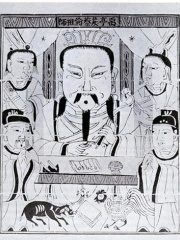
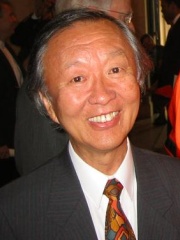
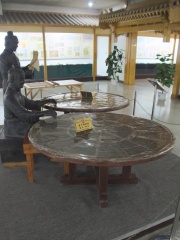
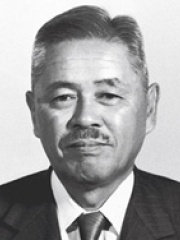
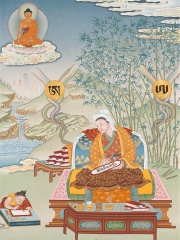

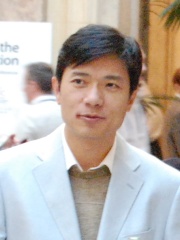
The Most Famous
INVENTORS from China
Top 8
The following people are considered by Pantheon to be the most legendary Chinese Inventors of all time. This list of famous Chinese Inventors is sorted by HPI (Historical Popularity Index), a metric that aggregates information on a biography's online popularity.

1. Cai Lun (48 - 121)
With an HPI of 79.13, Cai Lun is the most famous Chinese Inventor. His biography has been translated into 68 different languages on wikipedia.
Cai Lun (Chinese: 蔡伦; courtesy name: Jingzhong (敬仲); c. 50–62 – 121 CE), formerly romanized as Ts'ai Lun, was a Chinese eunuch court official of the Eastern Han dynasty. He occupies a pivotal place in the history of paper due to his addition of pulp via tree bark and hemp ends which resulted in the large-scale manufacture and worldwide spread of paper. Although traditionally regarded as the inventor of paper, earlier forms of paper have existed since the 3rd century BCE, so Cai's contributions are limited to innovation, rather than invention. Born in Guiyang Commandery (in what is now Leiyang), Cai arrived at the imperial court in Luoyang by 75 CE, where he served as a chamberlain for Emperor Ming, and then as Xiao Huangmen, an imperial messenger for Emperor Zhang. To assist Lady Dou in securing her adopted son as designated heir, he interrogated Consort Song and her sister, who then killed themselves. When Emperor He ascended the throne in 88 CE, Dou awarded Cai with two positions: Zhongchang shi , a political counselor to the emperor that was the highest position for eunuchs of the time, and also as Shangfang Ling, where Cai oversaw the production of instruments and weapons at the Palace Workshop. Despite Emperor He's successful coup d'état against the Dou family in 92 CE, Cai was undisturbed by his former ally's downfall. His position in the Palace Workshop increased in scope; he became responsible for the production of ceremonial weapons, which the Hou Hanshu reports were of exemplary craftsmanship. However, Cai's most noted innovation was in 105 CE, when he substantially improved the papermaking process with the use of tree bark, hemp waste, old rags, and fishnets. His new type of paper quickly displaced the bamboo and wooden slips used until then, and Cai received wealth and fame throughout the empire. In 110 CE, Lady Deng, who had become the empress dowager to the young Emperor An, appointed Cai to oversee 100 scholars' new edition of the Five Classics. Cai was rewarded for his imperial service in 114 CE; he received the title of marquis, and was enfeoffed lord of Longting, a small village. When his ally Deng died in 121 CE, Cai was ordered to the Ministry of Justice because of his involvement in the death of the emperor's grandmother, Consort Song. Ashamed at his predicament and expecting to be sentenced to death, he committed suicide that year and died in the capital city in which he had spent almost his entire adult life. Cai's improvements to paper-making are considered to have had an enormous impact on human history, and of those who created China's Four Great Inventions—the compass, gunpowder, papermaking and printing—Cai is the only inventor whose name is known. Although in China he is revered in ancestor worship, deified as the god of papermaking, and appears in Chinese folklore, he is mostly unknown outside of East Asia. His hometown in Leiyang remains an active center of paper production.

2. Charles K. Kao (1933 - 2018)
With an HPI of 69.49, Charles K. Kao is the 2nd most famous Chinese Inventor. His biography has been translated into 68 different languages.
Sir Charles Kuen Kao (simplified Chinese: 高锟; traditional Chinese: 高錕; pinyin: Gāo Kūn; November 4, 1933 – September 23, 2018) was a Hong Kong electrical engineer who contributed to the development and use of fibre optics in telecommunications. In the 1960s, Kao created various methods to combine glass fibres with lasers in order to transmit digital data, which laid the groundwork for the evolution of the Internet and the eventual creation of the World Wide Web. Born in 1933 in Shanghai, Kao and his family settled in Hong Kong in 1949. He graduated from St. Joseph's College in Hong Kong in 1952 and went to London to study electrical engineering. In the 1960s, he worked at Standard Telecommunication Laboratories, the research center of Standard Telephones and Cables (STC) in Harlow, and it was here in 1966 that he laid the groundwork for fibre optics in communication. Known as the "godfather of broadband," the "father of fibre optics," and the "father of fibre optic communications," he continued his work in Hong Kong at the Chinese University of Hong Kong, and in the United States at ITT (the parent corporation of STC) and Yale University. In 2009, Kao was awarded the Nobel Prize in Physics "for groundbreaking achievements concerning the transmission of light in fibres for optical communication." The following year, he was knighted by Queen Elizabeth II "for services to fibre-optic communications." Kao was a permanent resident of Hong Kong, and a citizen of the United Kingdom and the United States.

3. Bi Sheng (990 - 1052)
With an HPI of 68.70, Bi Sheng is the 3rd most famous Chinese Inventor. His biography has been translated into 33 different languages.
Bi Sheng (972–1051) was a Chinese artisan and engineer during the Song dynasty (960–1279), who invented the world's first movable type. Bi's system used fired clay tiles, one for each Chinese character, and was invented between 1039 and 1048. Printing was one of the Four Great Inventions. Because Bi was a commoner, not an educated person, little is known about his life besides this invention.

4. Taiichi Ohno (1912 - 1990)
With an HPI of 65.31, Taiichi Ohno is the 4th most famous Chinese Inventor. His biography has been translated into 24 different languages.
Ohno Taiichi (大野耐一, Ōno Taiichi; February 29, 1912 – May 28, 1990) was a Japanese industrial engineer and businessman. He is considered to be the father of the Toyota Production System, which inspired Lean Manufacturing in the U.S. He devised the seven wastes (or muda in Japanese) as part of this system. He wrote several books about the system, including Toyota Production System: Beyond Large-Scale Production.
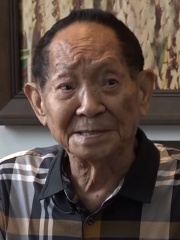
5. Yuan Longping (1930 - 2021)
With an HPI of 61.42, Yuan Longping is the 5th most famous Chinese Inventor. His biography has been translated into 29 different languages.
Yuan Longping (Chinese: 袁隆平; pinyin: Yuán Lóngpíng; September 7, 1930 – May 22, 2021) was a Chinese agronomist and inventor. He was a member of the Chinese Academy of Engineering known for developing the first hybrid rice varieties in the 1970s, part of the Green Revolution in agriculture. For his contributions, Yuan is known as the "Father of Hybrid Rice". Yuan was bestowed the Medal of the Republic, the highest honorary medal of the People's Republic of China, in September 2019. Hybrid rice has since been grown in dozens of countries in Africa, America, and Asia—boosting food security and providing a robust food source in areas with a high risk of famine. The technology allowed China to sustain 20% of the global population on 9% of global arable land, an achievement in food security for which he was awarded the 2004 World Food Prize and the 2004 Wolf Prize in Agriculture respectively.

6. Thonmi Sambhota (618 - 658)
With an HPI of 60.59, Thonmi Sambhota is the 6th most famous Chinese Inventor. His biography has been translated into 20 different languages.
Thonmi Sambhota (Thönmi Sambhoṭa, (Tib. ཐོན་མི་སམ་བྷོ་ཊ།, Wylie thon mi sam+b+ho Ta; c.619-7th C.) is a figure credited by Tibetan traditions with creating the first Tibetan script, based on the Gupta alphabet, after being sent by king Songsten Gampo to study in India. He is also credited with serving the king as his minister and escorting two princesses from Nepal and China into Tibet to become Songtsen Gampo's queens. The authenticity of this legend has been questioned.

7. An Wang (1920 - 1990)
With an HPI of 56.08, An Wang is the 7th most famous Chinese Inventor. Her biography has been translated into 21 different languages.
An Wang (Chinese: 王安; pinyin: Wáng Ān; February 7, 1920 – March 24, 1990) was a Chinese-American computer engineer and inventor, and cofounder of computer company Wang Laboratories, which was known primarily for its dedicated word processing machines. An Wang was an important contributor to the development of magnetic-core memory.

8. Robin Li (b. 1968)
With an HPI of 52.85, Robin Li is the 8th most famous Chinese Inventor. His biography has been translated into 25 different languages.
Robin Li Yanhong (Chinese: 李彦宏; pinyin: Lǐ Yànhóng; born 17 November 1968) is a Chinese software engineer and billionaire internet entrepreneur who is the co-founder and chief executive officer of Chinese multinational technology company Baidu. As of May 2025, his net worth was estimated at US$5.5 billion by Forbes. Li studied information management at Peking University and computer science at the University at Buffalo. In 1996, he created RankDex. In 2000, he founded Baidu with Eric Xu. Li has been CEO of Baidu since January 2004. The company was listed on NASDAQ on August 5, 2005. Li was a member of the 12th National Committee of the Chinese People's Political Consultative Conference from 2013 to 2018. During his tenure as CEO of Baidu, Li has been criticized for a number of controversies, including the death of Wei Zexi, advertising of unqualified hospitals on Tieba, and ad fraud.
People
Pantheon has 8 people classified as Chinese inventors born between 48 and 1968. Of these 8, 1 (12.50%) of them are still alive today. The most famous living Chinese inventors include Robin Li. The most famous deceased Chinese inventors include Cai Lun, Charles K. Kao, and Bi Sheng.
Living Chinese Inventors
Go to all RankingsDeceased Chinese Inventors
Go to all RankingsCai Lun
48 - 121
HPI: 79.13
Charles K. Kao
1933 - 2018
HPI: 69.49
Bi Sheng
990 - 1052
HPI: 68.70
Taiichi Ohno
1912 - 1990
HPI: 65.31
Yuan Longping
1930 - 2021
HPI: 61.42
Thonmi Sambhota
618 - 658
HPI: 60.59
An Wang
1920 - 1990
HPI: 56.08
Overlapping Lives
Which Inventors were alive at the same time? This visualization shows the lifespans of the 4 most globally memorable Inventors since 1700.

